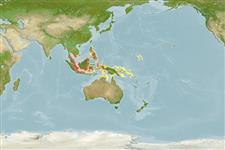Common names from other countries
Classification / Names / Names
Populärnamn | synonymer | Catalog of Fishes (gen., sp.) | ITIS | CoL | WoRMS
Environment: milieu / climate zone / depth range / distribution range
Ekologi
Revassocierade. Tropical
Western Central Pacific: throughout Southeast Asia, reaching the Philippines.
Length at first maturity / Size / Vikt / Age
Maturity: Lm ? range ? - ? cm Max length : 10.0 cm CW hane/ej könsbestämd; (Ref. )
Carapace ovate, covered with numerous very small granules; regions well defined; 4 broad lobiform teeth on each anterolateral margin. Eyes green in life. A larger molariform tooth at base of movable finger of larger chela. Carapace dirty-brown overall; eyes green, fingers black.
Occurs from shallow water to intertidal zones. Inhabits mangrove areas and prefers rocky areas, or areas densely covered by bivalves, such as Perna spp. Benthic. Tropical climate (Ref. 343).
Life cycle and mating behavior
Könsmognad | Reproduktion | Lek | Ägg | Fecundity | Larver
Members of the order Decapoda are mostly gonochoric. Mating behavior: Precopulatory courtship ritual is common (through olfactory and tactile cues); usually indirect sperm transfer.
Ng, P.K.L. 1998. (Ref. 343)
IUCN Red List Status (Ref. 130435)
CITES status (Ref. 108899)
Not Evaluated
Not Evaluated
Threat to humans
Harmless
Human uses
| FishSource |
Verktyg
Ytterligare information
Age/SizeTillväxtLength-weightLength-lengthMorfologiLarverAbundans
Internet-källor
Estimates based on models
Vulnerability
Low vulnerability (10 of 100).
Price category
Unknown.
